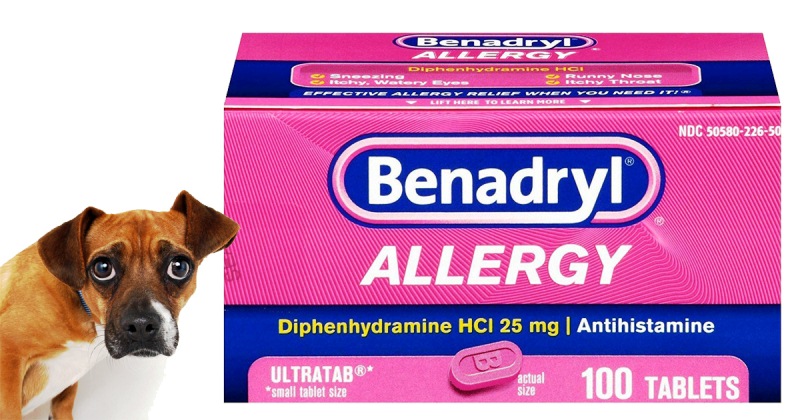Using Benadryl Safely for Dogs: A Guide Benadryl, also known as diphenhydramine, is a common over-the-counter drug used to treat a variety of conditions in humans. Interestingly, it is often used in veterinary medicine to treat similar problems in dogs. This guide explores the safe use of Benadryl for dogs, including its uses, dosages, methods of administration, safety precautions, and potential side effects.
What is Using Benadryl Safely for Dogs?
Benadryl is an antihistamine, a type of medicine that works by blocking histamine receptors in the body. Histamine chemicals are released by the immune system to allergens, leading to symptoms such as itching, swelling and inflammation. By blocking the receptors, Benadryl helps relieve them.
Using Benadryl Safely for Dogs
1. Allergies
One of the primary uses of Benadryl in dogs is to treat allergic reactions. Dogs are susceptible to allergies to a variety of substances, including pollen, dust mites, certain foods, and insect bites. Symptoms of allergies in dogs include itching, hives, swelling and redness. Benadryl helps relieve them by reducing the body’s histamine response Using Benadryl Safely for Dogs.
2. Anxiety and emotional illness
Benadryl has sedative properties that can be used to treat dogs. Dogs can help keep you calm during stressful situations like thunderstorms, lightning, or vet visits. Additionally, Benadryl can be used to prevent motion sickness in the car or on other trips, helping to keep your dog calm and comfortable.
3. Insect bites and stings
Insect bites and stings can cause local allergic reactions in dogs, leading to swelling, itching and discomfort. Benadryl is administered to reduce and relieve them. It is very useful in cases where the dog has been stung by bees or mosquitoes, helping to manage the allergic response.
4. Vaccine reactions
In some cases, dogs may have mild allergic reactions to the vaccine, manifested as swelling at the injection site, rash or mild fever. Benadryl can be used to relieve these symptoms and keep your dog comfortable after receiving vaccinations.
Form price Using Benadryl Safely for Dogs
The correct dose of Benadryl for dogs depends on their weight and overall health. A general rule of thumb is 1 milligram of Benadryl per pound of body weight, administered 2-3 times per day. However, it is important to consult a veterinarian before giving your dog any medication, even Benadryl. However, your recommendations may provide specific dosages based on your individual dog’s needs.
Here is the dosage chart in table format
| Dog Size | Weight Range | Dosage per Dose |
|---|---|---|
| Small dogs | 10-20 lbs | 10-20 mg |
| Medium dogs | 20-30 lbs | 20-30 mg |
| Large dogs | 30-40 lbs | 30-40 mg |
| Large dogs (40+ lbs) | 40+ lbs | 40-50 mg |

Administering Benadryl
Benadryl is available in various forms, including tablets, capsules, liquids, and topical applications. For dogs, tablets or liquid formulations are commonly used.
Tables
When using tablets, make sure you choose a Benadryl formula without any additional active ingredients such as acetaminophen or decongestants, which can be harmful to dogs. Crush the tablet and mix it with your dog’s food or put it directly in the mouth if it’s convenient for them.
Liquid
Liquid Benadryl is especially easy to administer to small dogs. Use a syringe or dropper to measure the correct dose and gently drop it into the dog’s mouth. Make sure you use baby formula like adult Benadryl with alcohol or other ingredients that are not safe for dogs.
Health tips
Although Benadryl is generally safe for dogs, you should take some precautions to protect your dog’s health and safety.
1. Consult your veterinarian
Before giving your dog Benadryl, consult your veterinarian to ensure it is appropriate for your specific condition and health status. However, you can provide guidance on proper dosage and any potential interactions with other medications your dog may be taking.
2. Avoid human formulas with added ingredients
Many products designed for people on Benadryl contain active ingredients such as acetaminophen or decongestants that are toxic to dogs. Always choose a plain Benadryl product and double check the label for any harmful additives.
3. Monitor for side effects
Although Benadryl is generally well tolerated, some dogs may experience side effects. Common side effects include yawning, dry mouth, urinary retention and in some cases hyperactivity. If you notice any unusual behavior or symptoms after giving your dog Benadryl, contact your veterinarian immediately.
4. Use with caution in dogs with certain health conditions
Benadryl is not suitable for dogs with certain health conditions such as glaucoma, high blood pressure, cardiovascular disease or urinary retention. Additionally, pregnant or nursing dogs should only take Benadryl under the guidance of a veterinarian. Always tell your vet about any pre-existing health conditions before giving Benadryl.
Potential side effects
Although Benadryl is generally safe for dogs, it can cause side effects in some cases. Knowing these potential effects will help you monitor your dog and respond appropriately if any adverse reactions occur.
Common side effects
1. Drowsiness: Benadryl’s sedative properties can cause drowsiness, which is often sought in the treatment or treatment of motion sickness. But avoid excessive sleep.
2. Dry mouth: Benadryl reduces saliva production, which can lead to dry mouth. Make sure your dog has access to fresh water to stay hydrated.
3. Urinary Retention: In some cases, Benadryl can cause difficulty urinating. Monitor your dog’s behavior in the bathroom and contact your veterinarian if you notice any problems.
4. Gastrointestinal upset: Some dogs may experience vomiting, diarrhea or hunger. If these persist, consult a veterinarian.
Rare side effects
1. Hyperactivity: While Benadryl generally has a calming effect, some dogs may become hyperactive or overly excited. This adverse reaction should be reported to your veterinarian.
2. Respiratory Problems: In rare cases, Benadryl can cause respiratory problems. If your dog has difficulty breathing, seek veterinary care immediately.
3. Allergic Reactions: Ironically, some dogs are allergic to Benadryl. Symptoms of an allergic reaction include swelling, hives, and difficulty breathing. If you suspect an allergic reaction, stop giving Benadryl and consult your veterinarian.
Using Benadryl Safely for Dogs is a powerful tool in managing a variety of conditions in dogs, from allergies and anxiety to motion sickness and insect bites. However, this medicine should be used carefully and responsibly. Always consult a veterinarian before giving your dog Benadryl to make sure it is appropriate for their specific needs and health condition. By following proper dosage guidelines, important side effects, and necessary precautions, you can help your dog get the benefits from Benadryl while minimizing any risks.



